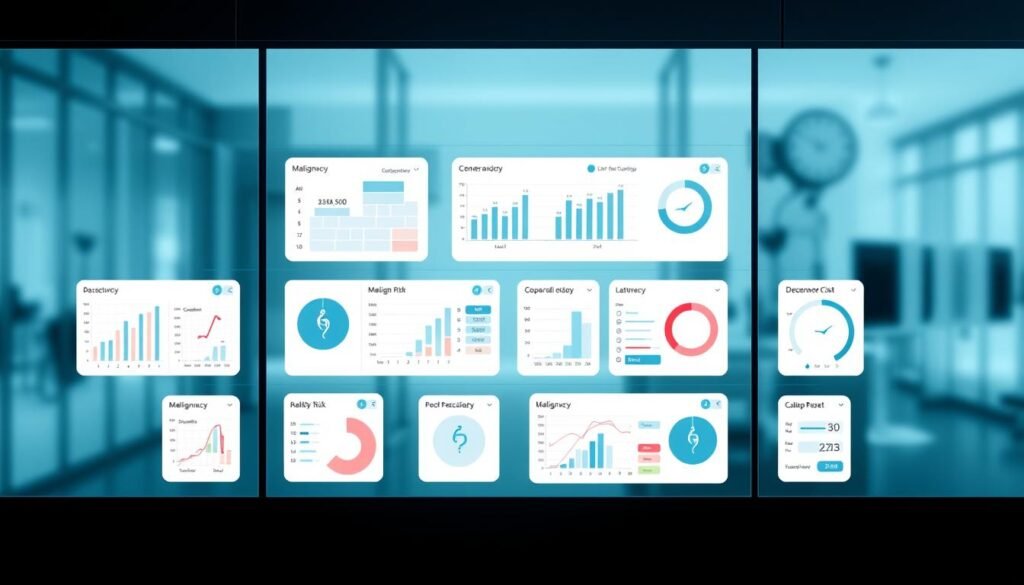Did you know that every year, about 1.6 million cases of pulmonary nodules are found in the U.S. alone? This shows how important it is to have tools for checking cancer risk. Malignancy calculators are key in this. They help doctors detect cancer early and make smart choices. By looking at a person’s clinical and personal details, these tools spot those more likely to get cancer.
Key Takeaways
- The incidence of pulmonary nodules emphasizes the importance of effective malignancy risk assessment.
- Malignancy calculators aggregate clinical data to improve patient risk evaluation.
- Accurate probability assessments can guide early detection strategies.
- Tools for cancer risk evaluation influence critical healthcare decisions.
- Identification of high-risk patients allows for tailored management strategies.
Understanding the Importance of Probability Assessment in Cancer Diagnosis
Probability assessment is key in diagnosing cancer. It helps decide the best management plans for those suspected of having cancer. It focuses on telling apart benign from malignant nodules. Many doctors struggle to follow the guidelines that stress this assessment’s value, leading to case mismanagement.
In the U.S., many people find pulmonary nodules every year. This highlights the need for better tools to assess cancer risk. Studies show progress in mathematical models aiming to improve these assessments. For instance, a model from Peking University People’s Hospital stands out for accurately separating benign and malignant nodules. This shows the importance of effective evaluation in clinical settings.
Using machine learning and statistics, healthcare can get better at spotting cancerous nodules. This helps not just patients but also cuts costs by using resources more wisely. Tools used to assess cancer risk are crucial for better patient care quality.
Understanding factors that influence malignancy risk leads to enhanced patient education and outcomes. It’s vital to include advanced analysis in regular health checks and cancer screenings.
A commitment to in-depth probability assessment lets doctors give patients the right treatment sooner. This improves their recovery chances. For additional information on the role of probability assessments in cancer diagnosis, check out this.
Key Factors Influencing the Probability of Malignancy
Many factors are crucial in figuring out the chance of cancer, especially with solitary pulmonary nodules (SPNs). Important elements include the patient’s smoking history, such as current, former, or never smokers. Age, how big the nodule is, and its shape greatly affect what happens next.
The size of the nodule is a big deal when guessing if it could be cancer. Big nodules, over 5 mm, often suggest a higher risk. On the other hand, tiny nodules, those under 5 mm, usually show a very low cancer risk, about 0% to 1%. But, the risk goes up as nodules grow bigger and show certain growth patterns.
The speed at which a nodule doubles in size can tell us about cancer risk. Faster doubling times usually mean a higher cancer risk. Features like spiculation in nodules are major clues, too. These clues help in making better guesses about cancer, helping doctors to choose wisely.
Recent studies show that using 11 factors can make our understanding of SPN risks much better. These models are pretty good, with about 78.84% sensitivity and 61.32% specificity. This means using many factors together helps in creating trustworthy guesses about cancer risks.
As our tech gets better, so does how we gather and analyze data on cancer risks. This means doctors and patients have better guides to follow. This helps in managing and improving cancer outcomes.
The Role of Predictive Oncology Tools in Patient Care
Predictive oncology tools use stats and clinical data to figure out cancer risks. They help doctors make better decisions by looking at things like age and health habits. This way, patients get care that fits their specific needs right on time.
Many models are now key in fighting cancer. The Gail model checks breast cancer chances, while Adjuvant! predicts if it might come back. These tools offer deep insights and make dealing with cancer a bit easier.
Modern tools also look at genes to make predictions. Take the log odds formula for prostate cancer—it considers PSA levels for a tailored forecast. Using a mix of predictors makes these estimates more reliable. It’s all about seeing the big picture.
The QCancer series in the UK shows how these models have grown. They use huge data sets to guess cancer risks based on specific symptoms. This helps doctors focus care where it’s needed most, making health systems more efficient.
| Prediction Model | Cancer Type | Key Factors Considered |
|---|---|---|
| Gail Model | Breast Cancer | Age, family history, past biopsies |
| Adjuvant! Online | Breast Cancer | Stage, tumor characteristics, age |
| Framingham Risk Calculator | Coronary Events | Age, gender, cholesterol, blood pressure, smoking status |
| QCancer | Multiple Cancers | Symptoms, prior health records |
Different Types of Malignancy Calculators
Many cancer calculators help doctors understand tumor risks. They use different information to measure the chance of having cancer. The VA and Mayo Clinical Models are well-known examples. These models look at various details to figure out cancer risk.
Here are some things they consider:
- Smoking history
- Nodule size
- Patient age
By putting patients into groups—low, medium, and high risk—these tools help doctors manage care.

How well these calculators work is important. For instance, one model could tell the likelihood of cancer in pancreatic cysts. It found that certain nodules increased cancer risk four times.
Tumor size and other factors also play a big role in assessing risk.
| Risk Factor | Odds Ratio | Confidence Interval | p-Value |
|---|---|---|---|
| Enhanced Mural Nodules | 4.314 | 1.618–11.503 | 0.003 |
| Tumor Diameter ≥ 40 mm | 3.514 | 1.138–10.849 | 0.029 |
| Main Pancreatic Duct Dilatation | 3.267 | 1.230–8.678 | 0.018 |
| Preoperative Neutrophil-to-Lymphocyte Ratio ≥ 2.288 | 2.702 | 1.008–7.244 | 0.048 |
| Preoperative Serum CA19-9 ≥ 34 U/mL | 3.267 | 1.274–13.007 | 0.018 |
Cancer calculators play a big role in medical care. They help doctors make smart choices for their patients. Using these tools, medical teams can offer care that fits each person’s needs.
Using the calculator to assess the probability of malignancy
Malignancy calculators are tools used by doctors. They use complex formulas to estimate cancer risks. This helps doctors make better decisions for their patients.
How the Calculator Works
A “cure model” forms the calculator’s heart. It turns data into cancer survival estimates over five years. The model uses information from over 230,000 colorectal cancer patients. This info comes from the SEER cancer databases between 2004 and 2015.
By putting together many factors, the calculator gives a precise risk estimate. This helps doctors in diagnosis and treatment planning.
Input Parameters Required
To work right, the calculator needs certain information:
- Age of the patient
- Smoking status
- Nodule size (in centimeters or millimeters)
- Recent cancer history
These details are crucial. They allow doctors to figure out cancer risk using the calculator. This makes patient care better.
Interpretation of Results
The calculator puts patients in different risk groups. Knowing the risk group helps decide what steps to take next. For example, a high risk might mean more tests or a biopsy is needed.
For patients with severe organ disease and cancer history, a high probability suggests they might need an organ transplant. Doctors use these results to plan care suited to each person. They consider other health issues and past treatments too.
Comparative Analysis: Clinical Judgement vs. Calculator-Based Predictions
In the world of cancer risk, we have two main ways to look at it: clinical judgement and calculator-based predictions. Doctors use their experience and gut feelings to make personal assessments in clinical judgement. However, this method might not always be consistent.
Calculator-based predictions, on the other hand, bring in a level of precision. For example, a study with 151 veterans looked at lung nodules sizes 7 to 30 mm. The results showed that tools like the Mayo Clinic model are quite accurate with a score of 0.80.
Clinical judgement has a downside of sometimes not following guidelines. This can lead to either too much or too little treatment. Using models like the Mayo Clinic and VA help make things more standard and predictable.

It’s important to know how common cancer is in evaluations. A study showed a 54% cancer rate among certain patients. This tells doctors to look at local data when they think about cancer risks. Mixing doctor insight with calculators can give a fuller picture of cancer risk.
| Assessment Method | Area Under ROC Curve | Confidence Interval | Prevalence of Malignancy |
|---|---|---|---|
| Mayo Clinic Model | 0.80 | 0.72 – 0.88 | N/A |
| VA Model | 0.73 | 0.64 – 0.82 | 54% |
Using both doctors’ insights and calculators leads to better cancer evaluations. This mix shows in studies how to get the best outcomes for patients. It’s about sticking to what’s best in cancer care.
Advantages of Utilizing Computational Cancer Diagnostics
Computational cancer diagnostics offer strong benefits that improve patient care. These tools use advanced algorithms and data analysis for better cancer detection. They provide precise assessments, improving their accuracy. This is due to their ability to focus on patient-specific factors. These calculators use machine learning and artificial intelligence to make risk evaluation easier.
The benefits include:
- Enhanced diagnostic accuracy: These diagnostics are more accurate than old methods, helping detect cancer early.
- Improved patient outcomes: Identifying cancer risks quickly can lead to better care and treatment outcomes.
- Resource efficiency: They decrease the need for invasive tests, making medical resources usage more efficient.
Cancer is a top cause of death worldwide, with about 19.3 million new cases each year, says GLOBOCAN 2020. These computational tools are very important in this fight. They help doctors make better decisions and provide personalized care.
These tools also help quickly check low-risk patients. This means doctors can make better plans for their care. People feel less stressed as they need fewer invasive tests. This shows how important these calculators are in changing cancer diagnosis and care. They push us towards a future where our decisions are based on more reliable data.
Real-World Applications of Malignancy Calculators in Clinical Settings
Malignancy calculators are now key tools in clinics. They are particularly useful for looking at solitary pulmonary nodules (SPNs). A study of 375 veterans showed a 54% prevalence of malignant SPNs. This highlights how vital these calculators are in spotting patients at high risk. Their real-world applications fit well with clinical rules. This helps healthcare providers make better decisions.
These calculators allow for a uniform way to handle patients, especially for general practitioners. For example, after using these risk calculators, doctors were 26% more likely to send patients for further checks.
Additionally, there was a change in the referral choices for 3% of the cases. General practitioners got better at estimating risks with time, thanks to the calculators. The Mayo Clinic’s model is especially good, with an area under the curve (AUC) of 0.83. This makes it a top-notch tool for predicting cancer chances.
Using these calculators not only fits with guidelines but also boosts patient care. Research into factors that raise lung cancer risk (like age and smoking) adds valuable data. This helps in better sorting of patient care.
| Predictor | Odds Ratio (OR) | 95% Confidence Interval (CI) |
|---|---|---|
| Positive smoking history | 7.9 | 2.6 to 23.6 |
| Older age (per 10 years) | 2.2 | 1.7 to 2.8 |
| Larger nodule diameter (per 1 mm) | 1.1 | 1.1 to 1.2 |
| Time since quitting smoking (per 10 years) | 0.6 | 0.5 to 0.7 |
The role of malignancy calculators in healthcare keeps growing, leading cancer diagnosis into the future. For more on their impact across different groups and their accuracy, check the insights from the European Randomized Study on Prostate Cancer. Also, learn about lung cancer risk with the TNM staging system.

Case Studies Demonstrating Effective Risk Assessment
Case studies help us see how malignancy calculators work in real life. They show us their role in making decisions about patient care. This is crucial for understanding how these tools help.
A 62-year-old woman was screened for cancer because she smoked a lot. The Mayo calculator estimated her cancer risk by looking at things like the size of the nodule and her age. This helped doctors decide on a plan early, which improved her chances of survival.
There was a 47-year-old man with a nodule in his lung that was hard to identify. Using the Brock model, doctors could figure out his risk of cancer. This helped them decide to do more scans instead of jumping to surgery.
Using malignancy calculators has made a big difference. Fewer people are being diagnosed with advanced lung cancer now. More are finding it when it’s still localized. This is after new screening guidelines were put in place. For more info, visit lung cancer screening guidelines.
These stories show how important malignancy calculators are. They help doctors make better choices. This leads to better care for patients and helps catch cancer early.
It’s becoming more important for doctors to use these calculators. They are becoming a key part of diagnosing and managing cancer. As cancer care gets better, these tools will be vital for finding cancer early and deciding how to treat it.
Conclusion
Calculators are now key in diagnosing cancer, particularly for lung nodules. These tools boost how well doctors can spot cancer, leading to better care for patients. Factors like age, gender, whether you smoke, and nodule features play a big role in cancer risk.
While predictive models are helpful, doctors’ own judgment still tops the charts in spotting cancer. Yet, there’s a gap in following the best practices for diagnosis. By using these calculators, healthcare pros can better manage risks. This helps them make choices based on strong data, leading to smarter care for patients.
The future of fighting cancer looks to tech for answers. Using these diagnostic tools is becoming crucial. They help doctors make precise treatment plans, aiming for the best possible health outcomes for their patients.